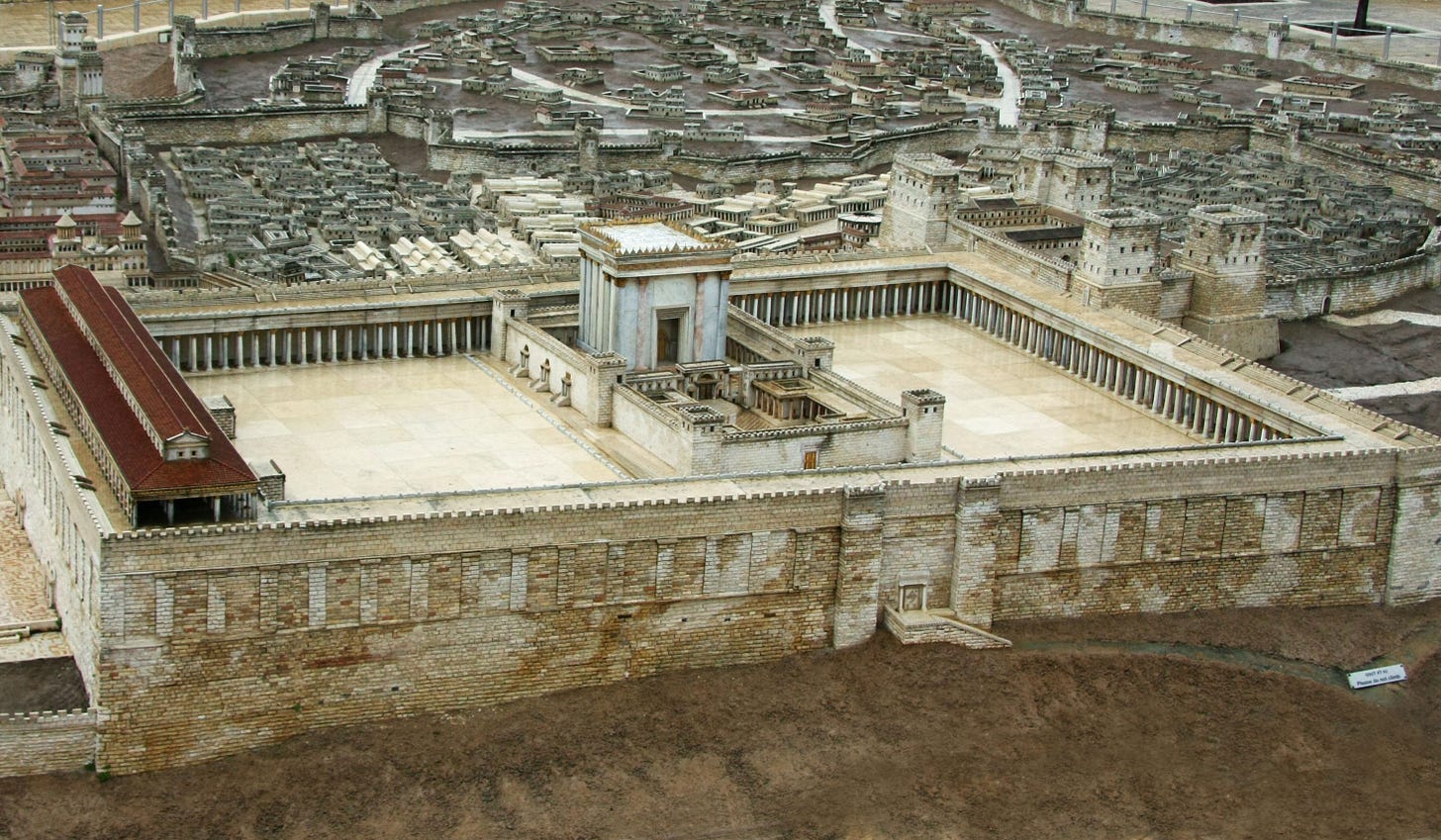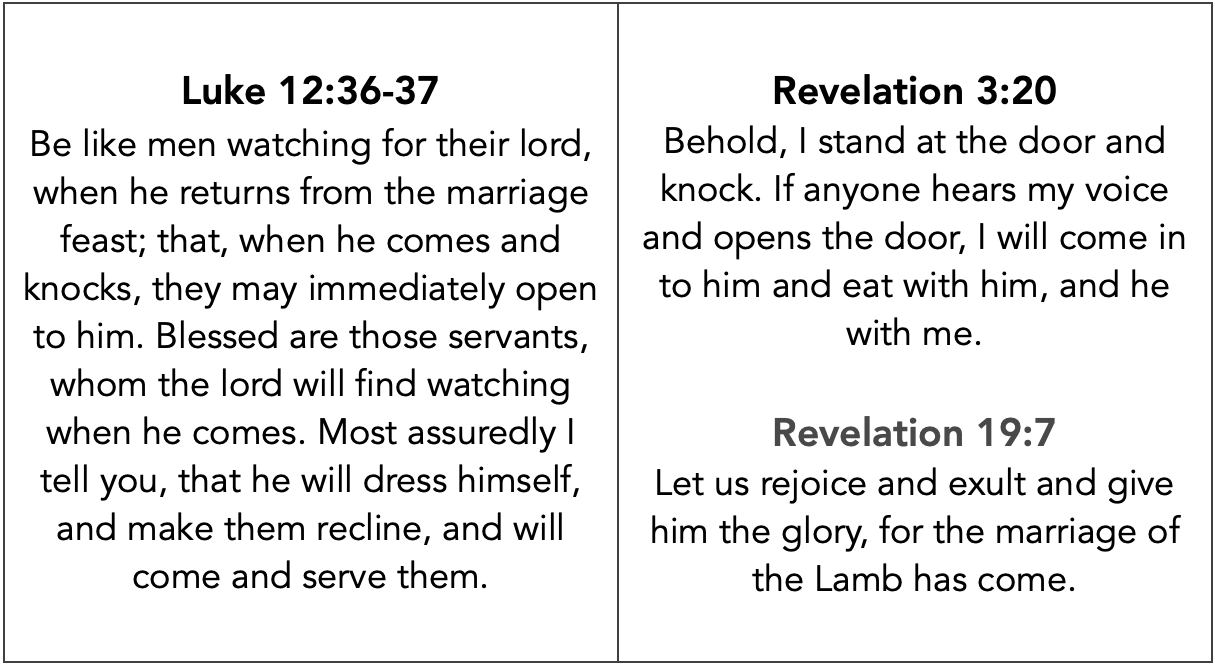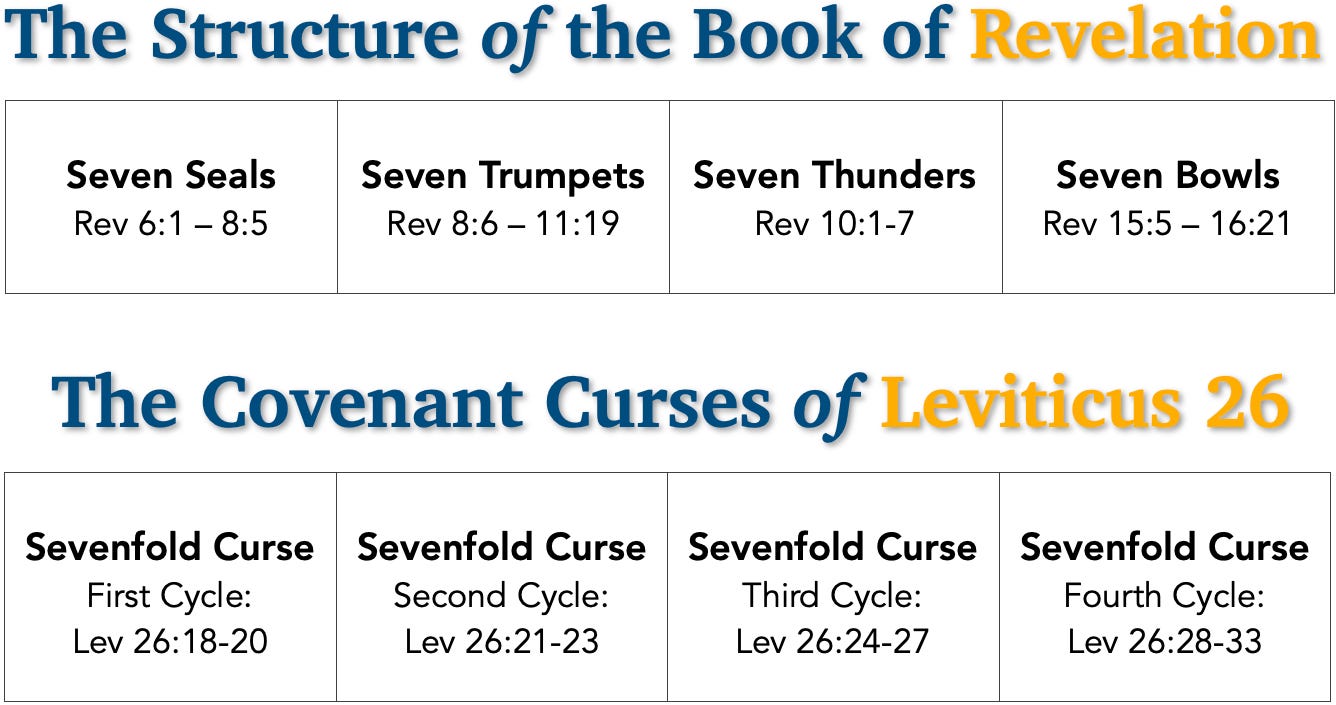A Pre-70 Date for Revelation?
Was the Bible's final book written before the fall of Jerusalem?
In several recent articles, I argued that the Gospels and Acts were written before the destruction of Jerusalem.1 But what about the Book of Revelation? According to most NT scholars, John wrote this text in the latter part of the first century, likely sometime after 90 AD, but I agree with a minority of scholars who have made a compelling case that the Apocalypse was written several decades earlier, during the reign of Emperor Nero (54-68 AD).2 In my opinion, one of the clearest ways of seeing this is by paying close attention to John’s statements about Jerusalem and its temple.
Imagine for a moment that I had a vivid dream related to the events of 9/11. Suppose I woke up in the middle of the night and wrote down the following sentence: “It will soon come to pass that planes will crash into the World Trade Center and the twin towers will fall.” If, on the following morning, I posted an article about my dream that included the above sentence, how do you think people would respond?
My own guess is that it would fail to impress my readers, since everyone is familiar with the events of September 11th, 2001. Still, some of my faithful followers might inquire about the date on which the dream occurred. Now, if in the comments section, I revealed that the dream was earlier that same week, this news would probably leave most of my readers scratching their heads. It’s one thing to write an article about an odd dream related to a well-known event, but it’s quite another thing to present that dream in the form of a prophecy of things to come. As we’ll see, this is the problem with the late-date view of Revelation.
In Rev 11:1-2, John was told to “Rise and measure the temple of God and the altar and those who worship there, but do not measure the court outside the temple; leave that out, for it is given over to the nations, and they will trample the holy city for forty-two months.” According to Josephus, Jerusalem and its temple were so thoroughly destroyed in 70 AD “that there was left nothing to make those that came thither believe it had ever been inhabited” (War 7.1.1). In light of this reality, however, how are we to make sense of John’s statement if Revelation was written decades after the Jewish War? Under this scenario, he would have been instructed to measure something that had already been destroyed, and he ended up saying that nations will trample (πατήσουσιν) the holy city, as if this event hadn’t yet occurred.
When this is put together with John’s repeated claim that he’s writing about “things that must soon take place” (Rev 1:1, 3, 2:16, 3:11, 11:14, 22:6-7, 10, 12, 20), a case could be made that the book of Revelation should be removed from the New Testament canon, since the author has essentially written history in the form of prophecy—which is a well-known characteristic of texts commonly dismissed as pseudepigrapha. It’s one thing to write about a historical event using apocalyptic imagery and language,3 but it’s another thing entirely to write about historical events that have already taken place in the form of a prophecy of something that is just about to happen (Rev. 1:19, 3:10, 16, 6:11, 10:7, 12:5).4 Such writing requires no supernatural insight of any kind and is very likely to be a work of deception.5
For some late-date advocates, one way of getting around this problem is to argue that John was actually referring to a future end-time temple that has yet to be built. Tim LaHaye advocates this view in his book, Revelation Unveiled, and writes, “This temple, then, will be built at the beginning of the Tribulation, for in the middle of it…the Antichrist will break his league with the Jews and set up his idol in the midst of the Temple.”6 Unfortunately, this interpretation is far removed from the actual words of Rev 11:1-2 and makes little sense in light of John’s repeated warning to his first-century readers and hearers that the things he writes about will begin to happen immediately.7 Additionally, if John was referring to a later end-time temple, how would any of his readers be able to know this without some kind of hint in his text to the effect that one day in the distant future a new temple would be rebuilt in Jerusalem?8
Another way of solving the problem is by insisting that John used symbolic language to refer to perennial issues throughout the church age. For example, according to G.K. Beale, Rev 11:1-2 does not refer to a literal temple in Jerusalem, but rather to “the whole covenant community dwelling in a spiritual temple in which God’s presence dwells.”9 Various features of the temple specifically mentioned by John are also given a figurative interpretation. The altar “refers to the way God’s people now worship in the community,” and the outer court “must therefore represent the church in its exposure and vulnerability to the world system in which it lives.” John’s reference to a period of “forty-two months” is also not literal, but represents the entire “church age,” which was “inaugurated at Christ’s resurrection, and will be consummated at His final coming.”10
As with the futurist approach, this interpretation fails to do justice to the numerous temporal indicators scattered throughout John’s narrative. Though it’s hard to tell when reading most English translations, the temporal intensifier μέλλω appears over 12 times in the book of Revelation, indicating that the things John described were “about to happen.”11 The time was near,12 and these things would take place very soon.13 Are all these time references merely figures of speech?
This interpretation also overlooks the fact that Rev 11:2 includes a specific allusion to words found in Luke’s version of the Olivet Discourse. According to Lk 21:20-24, Jesus says the following:
But when you see Jerusalem surrounded by armies, then know that its desolation is at hand. Then let those who are in Judea flee to the mountains. Let those who are in the midst of her depart. Let those who are in the country not enter therein. For these are days of vengeance, that all things which are written may be fulfilled. Woe to those who are pregnant and to those who nurse infants in those days! For there will be great distress in the land, and wrath to this people. They will fall by the edge of the sword, and will be led captive into all the nations. Jerusalem will be trampled down by the Gentiles, until the times of the Gentiles are fulfilled.
Here’s a side-by-side comparison of Lk 21:24 with Rev 11:2:
In light of the striking linguistic parallels, perhaps we should at least consider the possibility that both Jesus and John had the same trampling in view.14 Furthermore, in the final verse of Luke’s Olivet Discourse (21:36), Jesus tells his followers to “be watchful all the time, asking that you may be counted worthy to escape all these things that are about to come to pass” (μέλλοντα γίνεσθαι),15 which is a good indication that he was specifically referring to the events of that generation.16
Behold, I Stand at the Door and Knock
Another fascinating parallel is found when we compare Lk 12:36-37 with Rev 3:20. Though the passage from Revelation is often cited in evangelistic contexts as if Jesus is standing at the door of every person’s heart, when this verse is compared with Luke 12, it appears that he was instead referring to his teaching about the end of the age.
In Luke 12, Jesus instructed his followers to be on the lookout for his return, so that when he knocks, they will immediately open the door for him. However, in Revelation 3, Jesus tells the church at Laodicea that he is already standing at the door knocking. This provides us with another important clue that John’s temporal language should be interpreted literally rather than figuratively.
The Great Tribulation
Another important clue relates to Jesus’ teaching about the great tribulation (Mt 24:21; cf. Mt 24:29, Mk 13:19, 24). What few commentators seem to have noticed is that, according to Rev. 1:9, this intense period has already started, since John describes himself as a “partner in the tribulation.” In fact, according to Rev 6:11, martyrs were given white robes and told to rest for a short time, until the full number of servants “who were about to [μέλλω] be killed as they were, should be complete.” Then in the next chapter, John describes saints wearing “white robes…coming out of the great tribulation” (7:14).
In my thinking, however, the most important clue relates to the structure of Revelation itself. As the book unfolds, readers are warned about a variety of coming judgments that are dispensed in a repeating cycle of seven curses. Thus, there are seven seals (Rev 6:1-8:5), seven trumpets (Rev 8:6-11:9), seven thunders (Rev 10:1-7), and seven bowls. But this is precisely the pattern we find outlined in Leviticus 26 if the Israelites break their covenant with Yahweh. The covenant curses are dispensed in a repeating cycle of four sevenfold curses.
Ultimately, the book of Revelation is not about an end-time tribulation period off in the distant future, nor is it a symbolic depiction of the entire “church age.” Rather, it’s a Jewish text that was meant to signal the beginning of the end. What was in view, however, was not the end of the world, but rather, the end of the Mosaic Covenant, which is why the temple, with all its sacrifices, had to go. According to Hebrews 9:8-9, the holy place within the temple was itself “symbolic of the present age.” Therefore, the fact that not one stone was left to stand upon another in 70 AD was a clear indication that “the time of reformation” had finally dawned (Heb 9:10). Jesus taught his followers about these things at the beginning of that last generation, and John wrote down the words of his apocalyptic vision close to the end, just before the start of the Jewish War.
Shane Rosenthal is the founder and host of The Humble Skeptic podcast. He was one of the creators of the White Horse Inn radio broadcast, which he also hosted from 2019-2021, and he has written articles for Modern Reformation, TableTalk, Logia, Core Christianity, Beautiful Christian Life, as well as other sites and publications. His forthcoming book, Luke’s Key Witness, is due out later this year.
FOR FURTHER STUDY
Articles
The Implications of 70 AD, Shane Rosenthal
A Pre-70 Date for the Gospels & Acts, Shane Rosenthal
The Date of John’s Gospel, Revisited, Shane Rosenthal
Who is Babylon the Great? (Revelation Pt 1), Shane Rosenthal
Identifying Babylon (Revelation Pt 2), Shane Rosenthal
Revelation’s Temporal Clues (Revelation Pt 3), Shane Rosenthal
The Beast of Revelation (Revelation Pt 4), Shane Rosenthal
Nero’s Death & Rome’s Civil War (Revelation Pt 5), Shane Rosenthal
Episodes
Babylon, Humble Skeptic #66
Decoding The Prophecies of Daniel, Humble Skeptic #68
Who is Theophilus? Humble Skeptic #79
Did Josephus Ever Mention Jesus? Humble Skeptic #77
Is John Late & Unreliable? Humble Skeptic #51 with Daniel Wallace
Questioning Conventional Wisdom, HS #13 with David Rohl
Jacob’s Ladder, Humble Skeptic #63 with Richard Bauckham and others
Questioning The Fourth Gospel, HS #49 with Richard Bauckham
Books
Redating the New Testament, John A.T. Robinson
Redating Matthew, Mark & Luke, John Wenham
Rethinking the Dates of the New Testament, Jonathan Bernier
The Last Days According to Jesus, R.C. Sproul
End Times Bible Prophecy: It’s Not What They Told You, Brian Godawa
Revelation: Four Views, Steve Gregg
Before Jerusalem Fell, Kenneth Gentry, Jr.
The Divorce of Israel, Kenneth Gentry, Jr.
This includes scholars such as B.F. Wescott, F.W. Farrar, J.B. Lightfoot, Alfred Edersheim, Philip Schaff, John A.T. Robinson, Kenneth Gentry, R.C. Sproul, and Jonathan Bernier. One of the best arguments for a “Neronic” dating of Revelation relates to Revelation 17, which I discuss here (look for the section titled: “An Apocalyptic Timestamp”).
A good example of this is Rev 12:1-5, which uses symbolic language to describe Jesus’ birth and ascension. By the end of the narrative, however, all these events have already taken place.
This is sometimes hard to see in English translations, since the Greek temporal intensifier μέλλω often remains untranslated. In my opinion, this is a result of the eschatological presuppositions of the translators. For other NT texts featuring μέλλω outside Revelation, see Mt 12:32, 16:27, Mk 13:4, Lk 3:7, 21:7, 36, Heb 6:5, 10:1, 13:14, etc.
An excellent example of this is found in the Joseph Smith Translation of the English Bible, which is available here. Though the book of Genesis traditionally ends at 50:26, Smith’s version includes an additional prophecy in verses 31-33 of a man whose “name shall be called Joseph…after the name of his father; and…the thing which the Lord shall bring forth by his hand [in the latter days] shall bring my people to salvation.” Since Joseph Smith’s father was also named Joseph, it appears that the founder of Mormonism has inserted a prophecy of himself into the text of Genesis. It should be noted that this additional material is rejected by most Mormons and is only recognized as inspired by the “Reorganized Church of Jesus Christ of Latter-day Saints.”
Tim LaHaye, Revelation Unveiled (Grand Rapids: Zondervan, 1999) 185.
This is one of the definitions of the Greek word τάχος/ταχύς according to the Brill Dictionary of Ancient Greek. This word appears in Rev 1:1, 2:16, 3:11, 11:14, 22:6-7, 12, 20.
According to Heb 9:1-10, the temple, with its sacrificial system, was “a symbol of the present age” that was awaiting the time of reformation. In the futurist view, however, the sacrificial system will be reinstated when the temple is rebuilt, which appears to be a major step backwards. Why was nothing said about this fact?
G.K. Beale, Revelation: A Shorter Commentary (Eerdmans, Grand Rapids, 2015), 215-219.
Ibid.
μέλλω (Rev 1:19, 2:10, 3:2, 10, 16, 6:11, 8:13, 10:4, 7, 12:4-5, 17:8).
ἐγγύς (Rev 1:3, 22:10).
τάχος/ταχύς (Rev 1:1, 3:11, 22:6-7, 12, 20). According to BDAG, τάχος refers to “a very brief period of time, with focus on speed of an activity or event, speed, quickness, swiftness, haste.” We find this word in Acts 12:7 as an angel strikes Peter and tells him to “Get up quickly!” Also, Rev 12:12 informs us that the devil’s wrath is great “because he knows his time is short.”
For a similar chart and discussion, see Kenneth Gentry, The Divorce of Israel, Vol 2 (Acworth, GA: Tolle Lege Press, 2024), 881ff.
Once again, most English translations leave the temporal intensifier untranslated, but this exact phrase appears in the Apology of Justin Martyr and is translated “about to come to pass…” (1:42).
Cf. Mt 10:23, 16:28, 24:24, Mk 13:30, Lk 11:50-51, 21:32.







Shane, your contention that the Revelation was written prior to AD 70 is a compelling argument, and I'm leaning toward agreeing that the Revelation was written before the destruction of Jerusalem. And considering the fact that prophecies, while written before the fact, are always better understood later when fulfilled in real time. That's proven over and over by the way the disciples came to understand Jesus's previous prophecies about His death, but only after His death.
I did an experiment night before last. I decided to read through the book of Revelation in one sitting, trying to put aside what I would have said I now "know," and trying to absorb it as if hearing it for the first time. I thought of the descriptions in the book of Ezekiel (wheels in wheels, eyes all around, counterintuitive movements) and my prior conclusion that the human mind cannot "see" all those things simultaneously but rather cumulatively, if that makes sense.
I let the Revelation sweep me along. In my mind, I kind of compared my reading to watching a Lord of the Rings movie, where you know there is symbolism and details to look at more closely but you must postpone exploring it until later, just staying on for the sensory-overload ride.
All my life I've deflected any requests that I write and/or teach on the book of Revelation. Thirty-one books, and I never touched it other than references in other contexts. When I became Orthodox recently, I appreciated the Church's stance on not using it in Liturgy, not putting pieces of it up for consideration. The early church fathers pointed out how much controversy autopsying it brought in the early church (my words, not theirs, with apologies to those fathers.)
My reading just now confirmed that decision. It's a delicious multi-sensory wild ride treat for the faithful who refuse to get involved in arguments about it. As a whole, it tells me that He is King, He is worth dying for, that His enemies are multifaceted and terrifying but that they will be vanquished in the end. Everything is going to be all right.
Very coherent and well thought and written. Thanks.
What is your view on Daniel's words regarding Messiah cut oft in the middle of the last week (of years and tines of the Nations)? And the remaining 42 months, 1260 days, three and a half years and days? Are they not the time of those (us?) who are called to follow his footsteps, to - how bold of someone to say that, Paul - complete what is missing of the toils of the Anointed?
So that what he says and sees regarding Jerusalem, also will come to pass likewise to those who are called to be - with their bodies - the Temple of God (including those who - as it was in Jerusalem - pretend to be in such charge (yet, they are not his own: 'I do not "know" you')?